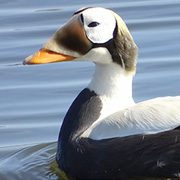Report Shows the Endangered Species Act Works for Birds
By Gustave Axelson
January 11, 2017

From the Winter 2017 issue of Living Bird magazine. Subscribe now.
The Endangered Species Act is often criticized. Some conservationists say it’s been weakened and watered down, while other critics say it’s a needless economic drag that benefits lawyers more than animals. In an issues primer for last November’s election, the American Farm Bureau Federation claimed: “the ESA has failed at recovering and delisting species since its inception.”
That’s just not true for birds, says a report by the American Bird Conservancy. ABC analyzed population trends since listing for all 96 bird species protected by the Endangered Species Act and found that more than 70 percent were increasing, stable, or have been delisted due to recovery.
“The Endangered Species Act is needed more than ever. In the past five years, seven U.S. bird populations were listed as threatened and endangered species,” said Steve Holmer, vice president of policy for the American Bird Conservancy. “On the bright side, our recent analysis shows that once listed, most birds are recovering, thanks in part to the ESA’s safety nets.”
Here’s the Breakdown:
The American Bird Conservancy report examined 96 taxa (including species and subspecies) that had been listed under the Endangered Species Act from 1973 to 2011. Outcomes fell into the following six categories, with examples for each:


Increasing: 42%
Example: Red-cockaded Woodpecker: Fewer than 10,000 birds were left at the time of ESA listing in 1973, but management efforts for longleaf pine habitat have helped the population grow by 50%.


Delisted: 13%
Example: Peregrine Falcon: Listed in 1973, the population in the Lower 48 states was down to just 650 breeding birds by 1975. Today the population has rebounded, thanks to a ban on DDT and the success of captive-breeding-and-release efforts. Delisted in 1999.


Stable: 16%
Example: Spectacled Eider: Surveys at a key breeding area in Alaska showed a population crash from 95,000 birds in the 1970s to 3,400 birds in 1992. After listing in 1993, the population stabilized at about 12,000 birds.


Declining: 21%
Example: Marbled Murrelet: The population that nests in old-growth trees in the Pacific Northwest and California was listed in 1992. At that time, the population was about 25,000 murrelets. Today it’s down to fewer than 20,000.


Extinct: 7%
Example: “Dusky” Seaside Sparrow: Protected in the Endangered Species Act of 1973, this subspecies went extinct due to draining and mosquito-control efforts in saltwater marshes in Florida.


Unknown: 2%
Example: “Coastal” California Gnatcatcher: Habitat loss and nest parasitism by Brown-headed Cowbirds drove the population of this subspecies down to about 2,500 birds at the time of listing in 1993. A 2008 partial survey tallied 2,648 birds, but no recent rangewide surveys have been conducted.
(Image credits: Red-cockaded Woodpecker by Martjan Lammertink; Peregrine Falcon by Jean Kohut; Spectacled Eider by Dena Turner/Macaulay Library; Marbled Murrelet by Moe Bertrand/Macaulay Library; “Dusky” Seaside Sparrow by P.W. Sykes/National Digital Library of the United States Fish and Wildlife Service; “Coastal” California Gnatcatcher by Ian Davies/Macaulay Library.)


All About Birds is a free resource
Available for everyone,
funded by donors like you

